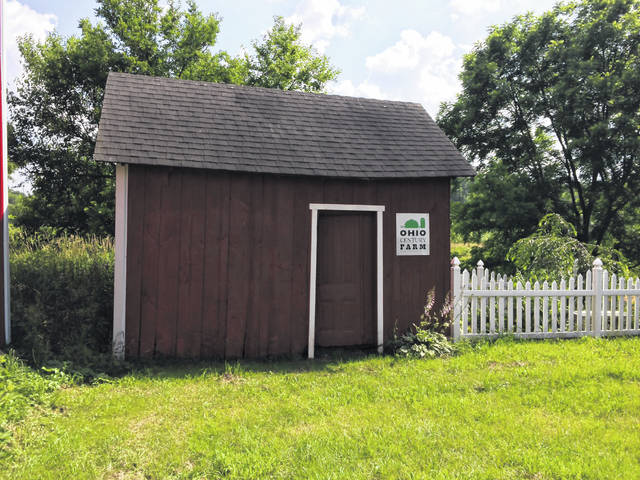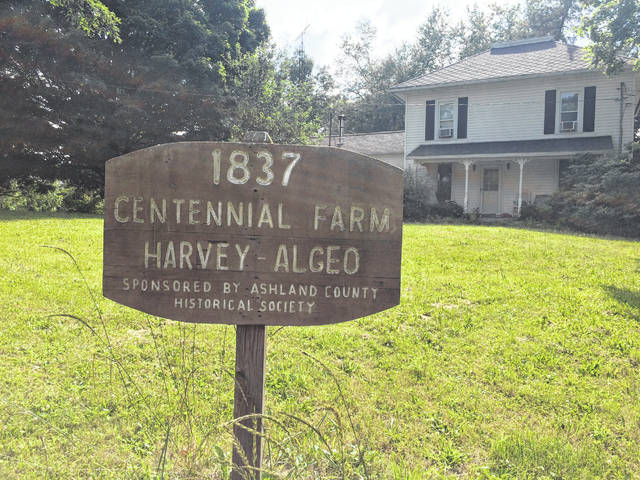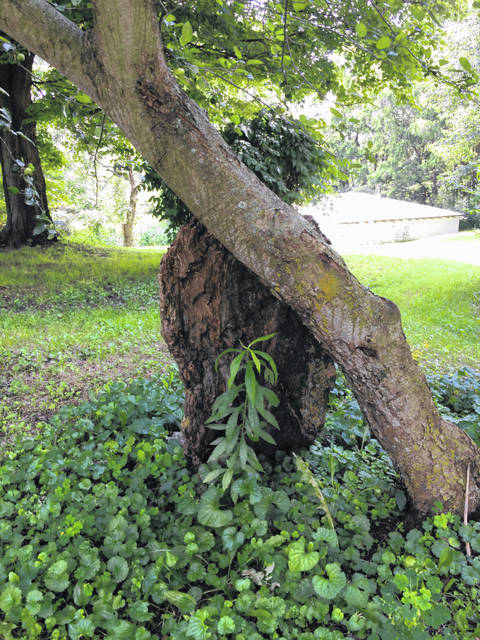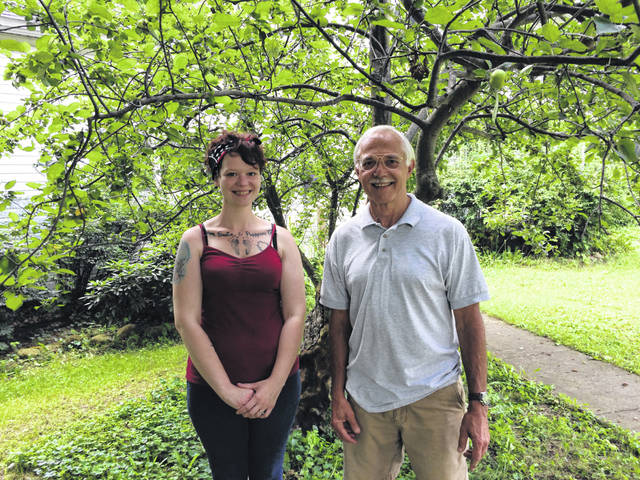



The apple tree is unassuming when you first see it. It looks like most other trees except for the large, gnarled piece of trunk around its base and the dark brown, circular stain in the soil beneath it.
Standing there in the warm midsummer breeze you can almost smell apples, but not quite. Yet something is in the air.
Unless someone told you, you would never know that you’re looking at a rare piece of Ohio’s history, one of the last known trees planted by Johnny Appleseed.
“Johnny Appleseed” was born John Chapman. He came “West” — to the Ohio country — from central Massachusetts by way of Pittsburgh, then down the Ohio River to Marietta.
In Marietta he started some of the town’s first apple nurseries before moving on. Likely he made this back-and-forth trip more than once.
From Marietta, Johnny Appleseed made his way upstream along the Muskingum and Tuscarawas Rivers, the Kokosing River (“River of Little Owls”), “White Woman’s Creek” (the Walhonding River) as it was known in the day, the Mohican, and the Jerome Fork of the Mohican, near where I grew up.
Once upon a time my friend and I traversed this same route in a canoe that I built in high school. I named my canoe Distant Thunder and there was a yellow lightning bolt painted across the bow. We put in along the banks of the Jerome Fork, drifting downstream, camping and dreaming of Indians, Johnny Appleseed and girls. But this is a story for another time, a story not for the faint of heart.
Along the way John Chapman collected apple seeds from the discarded pulp from cider mills. These were likely situated along the larger streams and rivers closer to the Ohio River. He dried the discarded apple seeds and carried them in a pouch, planting them in choice spots that he found as he traveled.
It is unlikely that he actually carried apple trees though he did, on occasion, exchange small seedlings to pioneers for a meal and a night’s stay. This is a matter of historical record in Richland and Ashland counties. This is home to me; and this is where “Johnny Appleseed” started many small apple tree nurseries along the fertile stream banks and river bottoms.
One of these fertile spots sits atop a glacial deposit in rural Ashland County, on the centennial farm/ homestead of Harvey Algeo. His great-great-great granddaughter (and my host for the day) Amy Paramore-Sheaffer and her husband Matt, still live on the farm, her roots running deep like the apple tree that Johnny Appleseed planted on their farm.
Soil scientists, and botanists who examined it say this is the reason for the tree’s ripe old age: a steady supply of water and mineral-rich nutrients runs deep underground, nourishing the tree and its deep root system for well over a hundred and fifty years.
The tree still produces apples today and they are the “Rambo” variety. The seeds were possibly brought to America in 1637, to the colony of New Sweden, by Peter Gunnarsson Rambo, a Swedish immigrant. His grandson recounted that he brought apple (and other) seeds with him in a box. The first Rambo apple tree could likely have grown from one of these seeds.
Interestingly, John Chapman — Johnny Appleseed — subscribed to the “Swedenborgian” belief, a perspective forwarded by the writings of scientist and Swedish theologian Emanuel Swedenborg. Among other things it taught that plants, animals and all life are to be respected.
Legend has it that Johnny Appleseed would not even kill a mosquito, that he would extinguish his campfire to prevent insects from dying. Perhaps there is truth to this legend and perhaps John Chapman’s Swedenborgian beliefs help us better understand a small part of a fascinating man.
William Coxe (in “A View of the Cultivation of Fruit Trees”, 1817) wrote that Rambo apples were grown heavily throughout Delaware, Pennsylvania, and New Jersey, and that the apple took its name from the family who introduced it—Peter Rambo.
In the 1915 horticulture book, “Varieties of Apples in Ohio”, Rambo apples were said to have been found in almost every old orchard in Ohio. It is quite possible that Johnny Appleseed planted many of these trees.
Rambo apples have a greenish-yellow skin, speckled grey. They ripen in early to late fall and they are medium-sized.
Amy, my host, said “the apples are tart but they make real good applesauce.”
She promised to send me one of her great-grandmother’s applesauce recipes, something I will treasure as another part of Ohio rich history.
By now you may be wondering, “Why did you drive three hours north just to look at a gnarly old apple tree?”
By now you know, though I didn’t go simply to look at an old tree and to hear stories. I went to touch history, and to bring a piece of history back with me.
I went to hear history too, and Amy Paramore-Sheaffer is quite the historian/storyteller, with many fascinating accounts of her farm, her family, and Johnny Appleseed: “Grandma said he slept in that red shed over there by the barn.”
Of course I had to look in the shed; but Johnny Appleseed was long gone. Was that apples I smelled when I opened the shed door…?
It was interesting and coincidental too, that I went to high school with Amy’s husband’s father. And oh, the stories that Matt and I shared about his father and my brother and our high school (mis)adventures!
I gathered from talking with Matt that his father (thankfully) hasn’t changed much in that respect. And from the twinkle in Matt’s eyes, and from the stories that he told I could see that the apple didn’t fall too far from the tree.
Let me clarify. When I said that I went to bring a piece of history back with me, I didn’t chop the apple tree down or anything like that.
With Amy and Matt’s gracious consent, and after explaining exactly what I proposed to do, I was allowed to carefully prune a dozen or so precious cuttings from the branches of the “Johnny Appleseed tree.”
I brought these back to our farm — Morning Meadow Farm in Blanchester — to graft to healthy root stock, to preserve a very special part of Ohio’s early history.
When the grafts take hold and their branches begin to produce their first apples many years from now, please stop by our farm and taste a piece of Ohio’s history: a Rambo apple, grafted and grown from one of the last trees that Johnny Appleseed ever planted.
You are always welcome to stop by.
We’ll leave the door open for you
L. Mark Kibler, M.Ed. served as an Interpretive Naturalist with the Ohio Department of Natural Resources at Shawnee, Deer Creek and Mohican State Parks for many years. He is a retired Environmental Education, Physics and Biology teacher and he was selected as a Teacher of the Year in New Hampshire. He is an Ohio native and he lives on a farm near Blanchester. Email him at [email protected].





